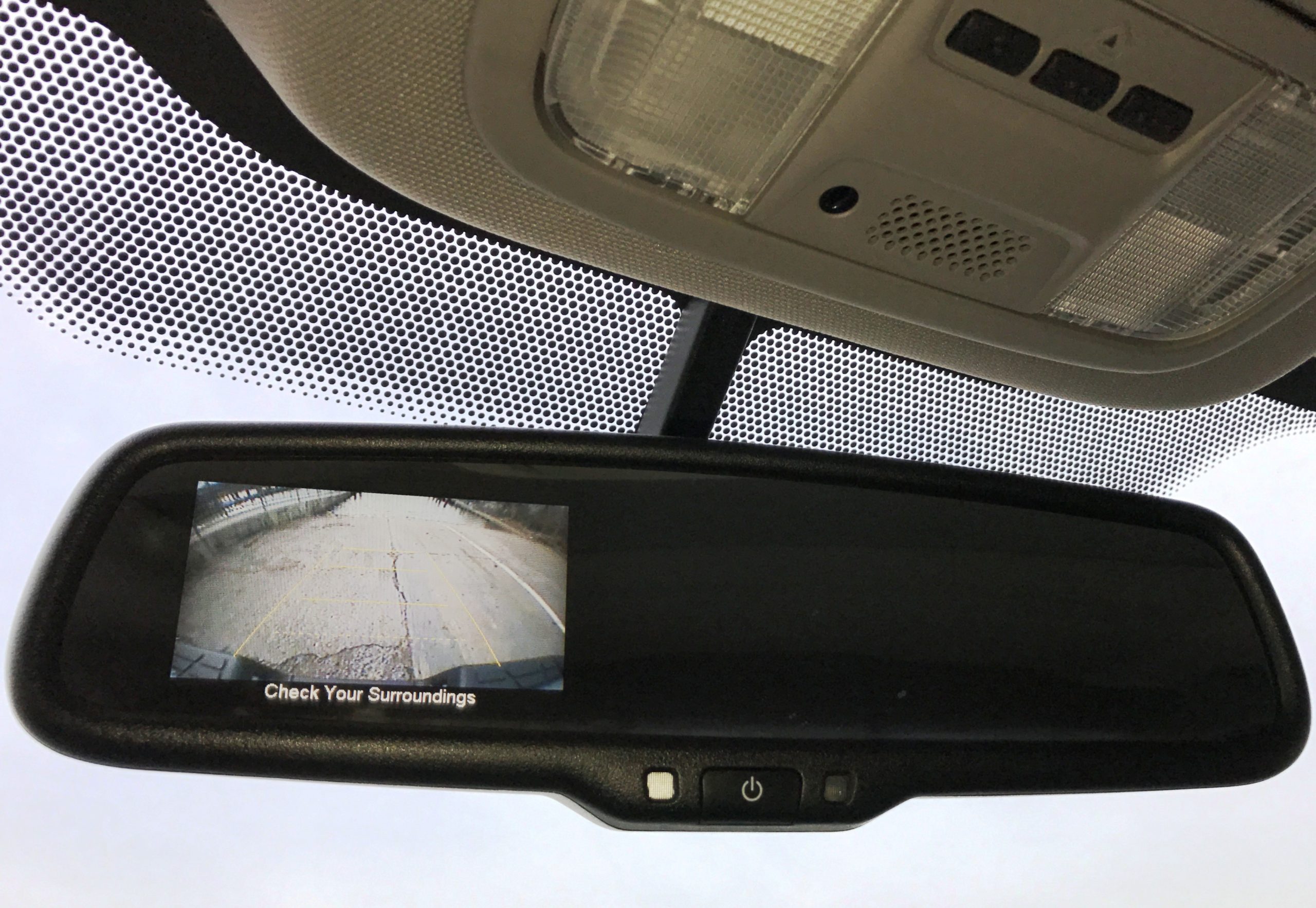When you think about the investment you made in your new RV, a surge protector for your RV should be a no-brainer. We are going to talk about what a surge protector is, how it works, and most importantly, why you need one.
An electrical power surge is a silent killer of your whole electrical system including those shiny new appliances. So, what is a surge protector for an RV?
What is a surge protector for an RV?
A surge protection device protects your RV from an electrical surge sent between the power pedestal and your RV. An electrical surge can be caused by many things such as an electrical storm, surge from the local power grid, malfunctioning electrical pedestal at your campsite, or even power line maintenance.
How does a surge protector work?
A Surge protector acts as a buffer between your RV and the power coming out of the electrical outlet. These devices can be either portable or hardwired to provide needed electrical protection.
A portable device is where you would plug them into the power pedestal and then plug your RV power cord into the surge protector. A hardwired device is permanently wired into the belly of your RV and the power cord is attached. All you need to do is plug into the power pedestal as you normally would.

Why do I need a surge protector?
Many RV parks have sketchy electrical pedestals set up at their campsites that have the possibility to do major damage to your investment. You need a surge protector to block any power surges that may get sent to your RV. A surge of electricity sent through your RV can cause damage to any appliance or electronic equipment that is plugged in.
A couple of hundred dollars is not a lot to spend when you think of the tens of thousands you spent purchasing your RV. Peace of mind goes a long way for me knowing I don’t have to worry much about the electrical pedestal I’m plugging into.
Is there a difference in surge protectors?
There are two different electrical surge protection devices you can choose from. Depending on how much you are willing to spend they have either an RV surge protector or an EMS device (electrical management system). We will cover the differences between the 2 a little further down.
Choosing the right RV surge protector or EMS product is pretty easy. If you have 50 amp service, buy a surge protector for 50 amp RVs. For RVers with 30 amp service, a 30 amp surge protector is sufficient. Costs vary but start at about $100 and go up from there depending on the level of protection.
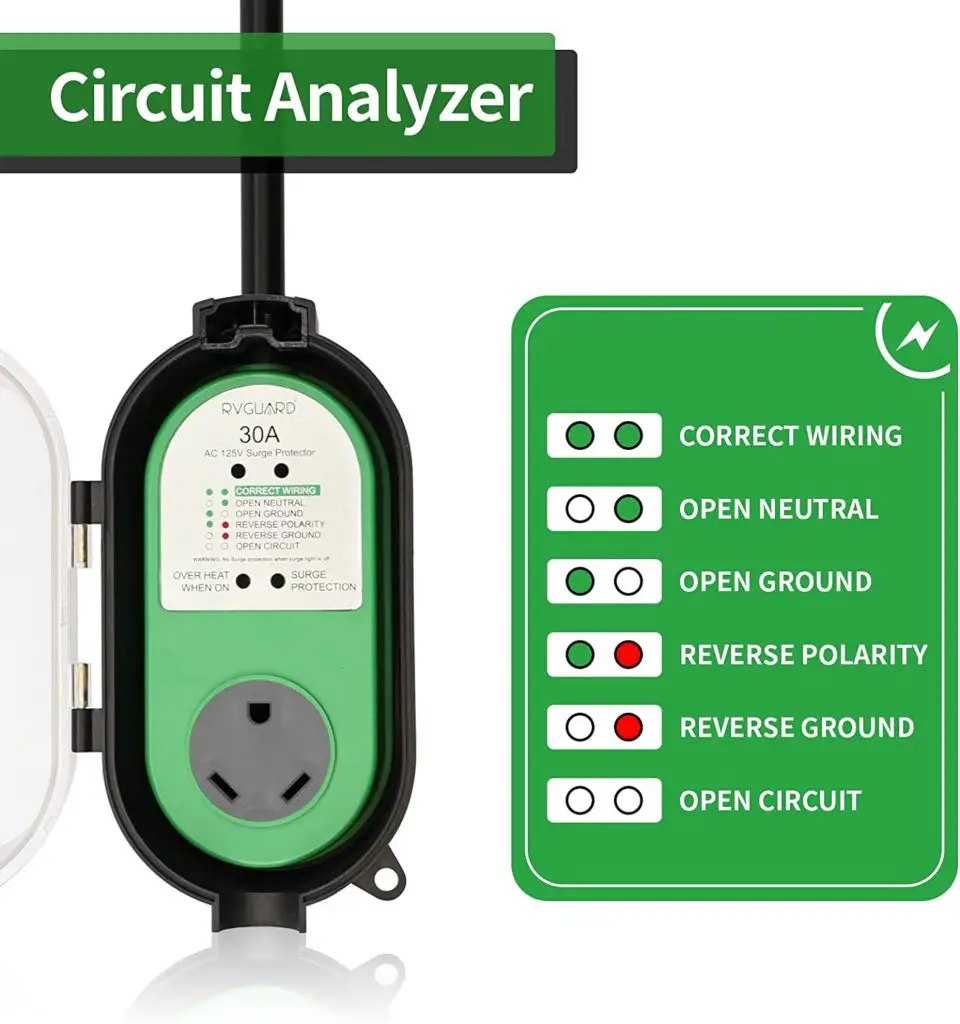
What should I look for in a surge protector?
Type of device
You really only have a couple of different options when searching for ways to protect your RV’s electrical system. You may see them called by many different names though. A Surge protector, electrical stabilizer, Surge suppressor, or EMS (electrical management system).
We are going to focus mainly on a traditional Surge Protector and the EMS device.
Surge protector
Mainly used for protection from large spikes of electrical activity. A surge protector is the more affordable of the 2 devices but also provides little to no monitoring of electrical activity.
EMS
Designed to protect your RV from a larger variety of potentially damaging electrical issues. This protection includes smaller power spikes, consistently damaging high or low voltages, open grounds, open neutrals, and reverse polarity.
It is designed to shut off power immediately when it identifies any issue that can create larger problems for your RV and its appliances.
30 Amp Or 50 Amp?
It is recommended to use a surge protector with the same amperage as your RV. It’s not advised to “mix and match” amps. If your RV has a 30-amp system, it’s best to use a 30-amp surge protector. The 30-amp surge protector runs on a single-leg, while a 50-amp surge protector has a two-leg system.
Portable or Hardwired protection
Portable
EMS systems or portable devices are best for “plug and play” versatility.
You can simply plug it into the power hookup at your site and then connect your RV’s power cord to the device.
With a portable device, you will be able to remove and install it every time you get settled in a new RV spot. Easily stores away between uses, but is ready to use when needed.
A portable surge protector or EMS is the easiest type to use.
You won’t need to worry about wiring it directly into your RV and it will be easier to replace (in the event of a failure) than a hardwired surge protector or EMS.
Even the EMS options for RV use come in portable and hardwired forms. Choosing between these two options is relatively simple.
Hardwired
A hardwired EMS system has its benefits too. You’ll need to hardwire it directly into your RV, but this type of system is durable and reliable.
Commonly, a hardwired EMS should be installed underneath your RV and in the same compartment, you typically use to access the power cord.
One of the benefits of this type of EMS is that you won’t have to worry about plugging in anything extra when you arrive at a new power hookup.
Your surge protector will also be concealed from view, which serves to reduce the risk of theft.
Weather also won’t be a concern because your EMS will be protected inside your RV storage compartment.
Display Or No Display?
At first glance, you might not feel like you necessarily need to know the information that a quality surge protector or EMS is monitoring once it’s plugged in.
As long as it works and keeps my RV safe, it’s all good, right?!
Well, here’s the thing. The more you know, the better you can look out for your RV’s electrical needs. Personally, I’ve always loved the idea of building out a van or tiny home from the ground up.
When it’s done, I’ll know exactly how everything is put together and works together.
That way, when something goes wrong, I’ll be able to buy the appropriate supplies and fix the issue myself (hopefully!).
I won’t have to rely on someone else’s opinion on a matter that I really know very little about and shell out a bunch of extra money for their labor.
At the end of the day, I think it’s extremely valuable to have a surge protector with an LED display.
This display should give you the ability to see a variety of information, such as voltage and frequency.
Find one that displays this information in a way that you can easily understand it and that is adapted to be readable in daylight or nighttime conditions.
Amp Rating
Every appliance in your RV requires a certain amount of electricity to be able to function. The other electronic devices you plug in also need their own unique amount of electricity to continue operating.
Make sure to check the amp rating on the surge protectors or EMS systems you’re looking into in order to make sure it will sufficiently power your appliances and devices.
Device amperage can add up quickly, especially when you factor in AC units, microwaves, and all the other nifty modern devices we all love these days.
Joules Rating
The joules rating on an RV surge protector or EMS largely dictates the degree of surge suppression or protection that it will provide for your RV.
One of the most important functions of a surge protector is the ability to dissipate heat when the amount of electricity coming from a power pedestal spikes unexpectedly.
A higher joules rating provides more protection against larger power spikes.
It also translates to an increased ability to prevent overheating when power spikes occur.
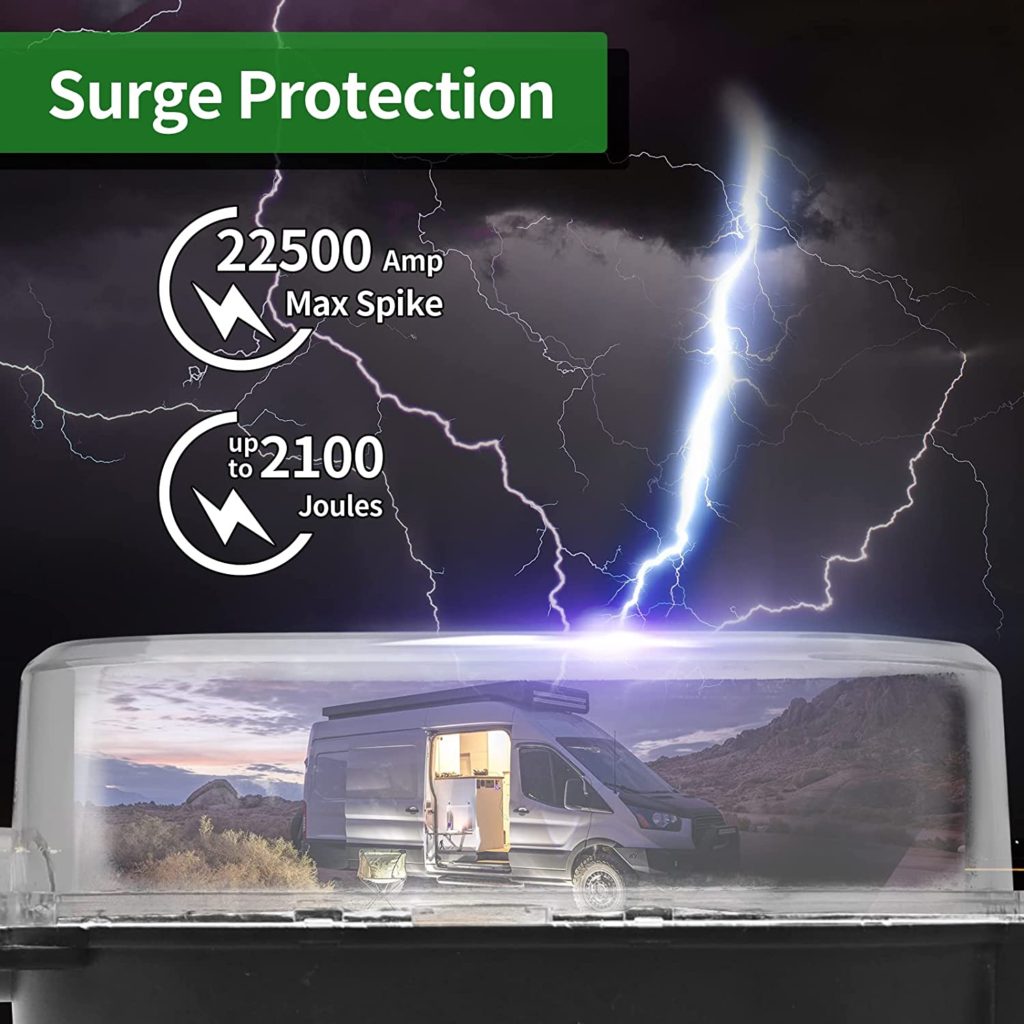
ETL or UL Certification
ETL stands for Edison testing Laboratories and UL stands for Underwriter Laboratories. These entities are a third-party organization that provides product certification standards with the goal of ensuring safety for both workers and consumers.
When searching for a quality surge protector or EMS system, make sure it has been given either one of these certifications.
Installation Requirements
As we mentioned earlier a portable surge protector is basically a plug n play device. it does not get much easier than that for setting up some protection at your campsite.
If you’re installing a surge protector or EMS in your RV for the first time, I recommend choosing a portable device that won’t require much effort to install.
Once you have more experience with surge protectors and their functionality, you can begin to think about installing a hardwired EMS or a more complicated surge protection system.
While installing an EMS or surge protector adds an important degree of protection and safety, improper installation can result in all sorts of prolonged and dangerous electrical issues.
Do your research first and know the product that you are installing. There is no use buying a device and ending up doing more bad than good.
Weight
When choosing between various portable EMS models, weight should come into play.
While it’s not the most important metric for choosing a surge protector, you also shouldn’t choose a surge protector that you’re going to have difficulty moving around and setting up every time you change locations.
Look for a healthy balance between compact size, lightweight design, and durable materials that provide a sufficient degree of weather protection.
There’s no reason to choose a super heavy surge protector that adds unnecessary weight to your RV and makes your life harder when you’re setting up in a new spot.
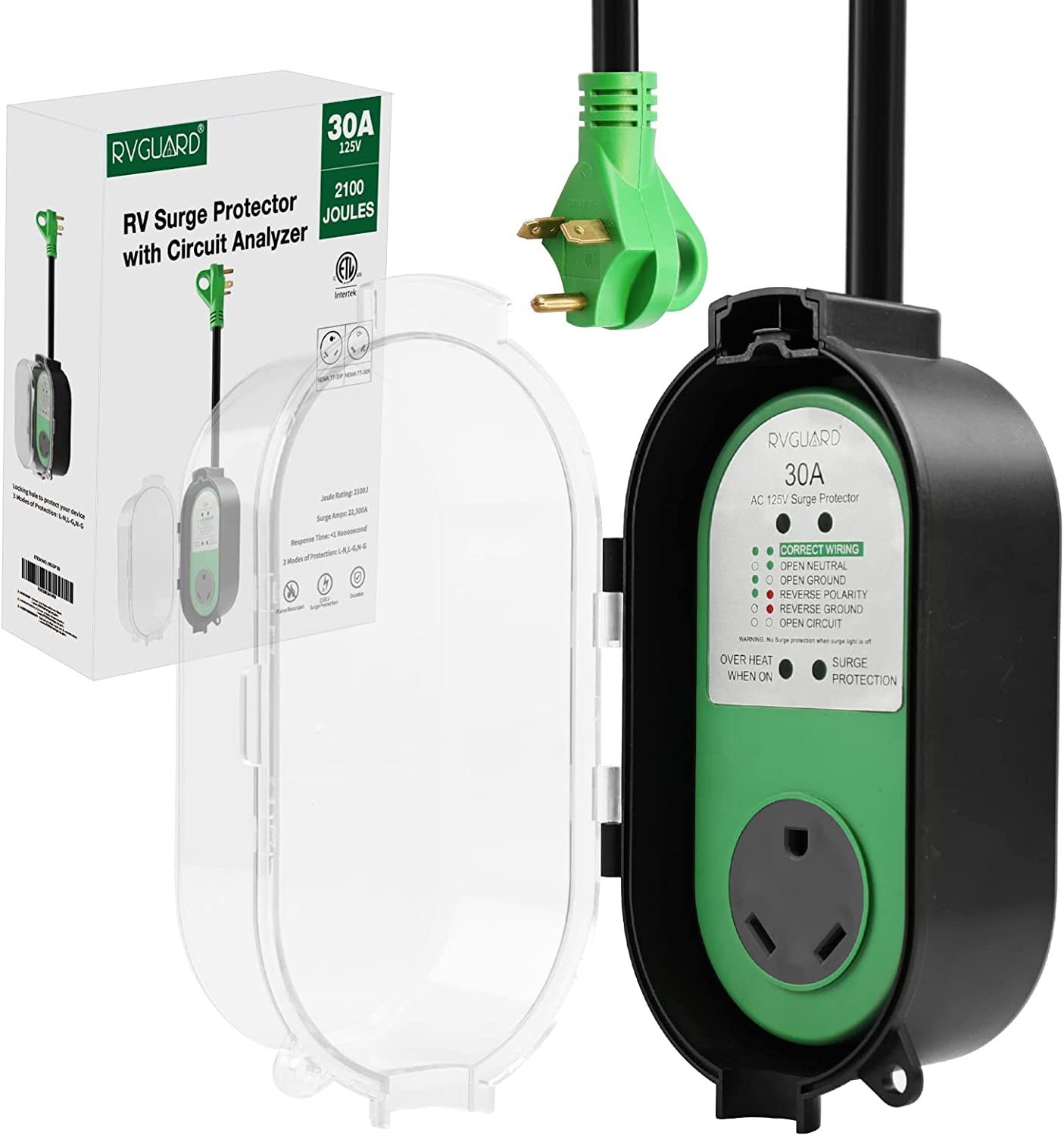

Budget
You can find surge protector prices running from one end of the spectrum to the other. A $100 is a good average price you will see for a pretty standard portable device. When you see lower-priced models, make sure to check reviews, and ask fellow RVers if they have used them.
Like everyone always says, you get what you pay for and when you are talking about protection for a $75K investment it speaks even louder.
For a better device that sets your peace of mind at ease, I would not spend less than $200 and probably more than $300.
If you have ever replaced a major appliance or redone the wiring in an RV, I think we can agree this is not much to spend.
This Is just my 2 cents and you can take it for what it is.
User Reviews
The last thing to check out before you buy an RV surge protector or EMS is how others have liked (or haven’t liked) their experience with the same model you’re thinking of purchasing.
User reviews are a great way to move past the manufacturer’s catchy advertising jargon and read about real-world experiences with the product.
Usually, if I only see a couple of reviews, I just move on. I want to see 50-100 reviews on a product before I use it to determine its value. It does not mean it is a bad product, just maybe new to the platform. You can check around at other places that sell it and see if they have reviews.
You really need to dig deep when reading reviews, because some people just like to complain. Some bad reviews have zero to do with the product itself but are more about packaging or servicing.
It is investigative work and multiple resources may be needed to know whether this is a product you will trust in.
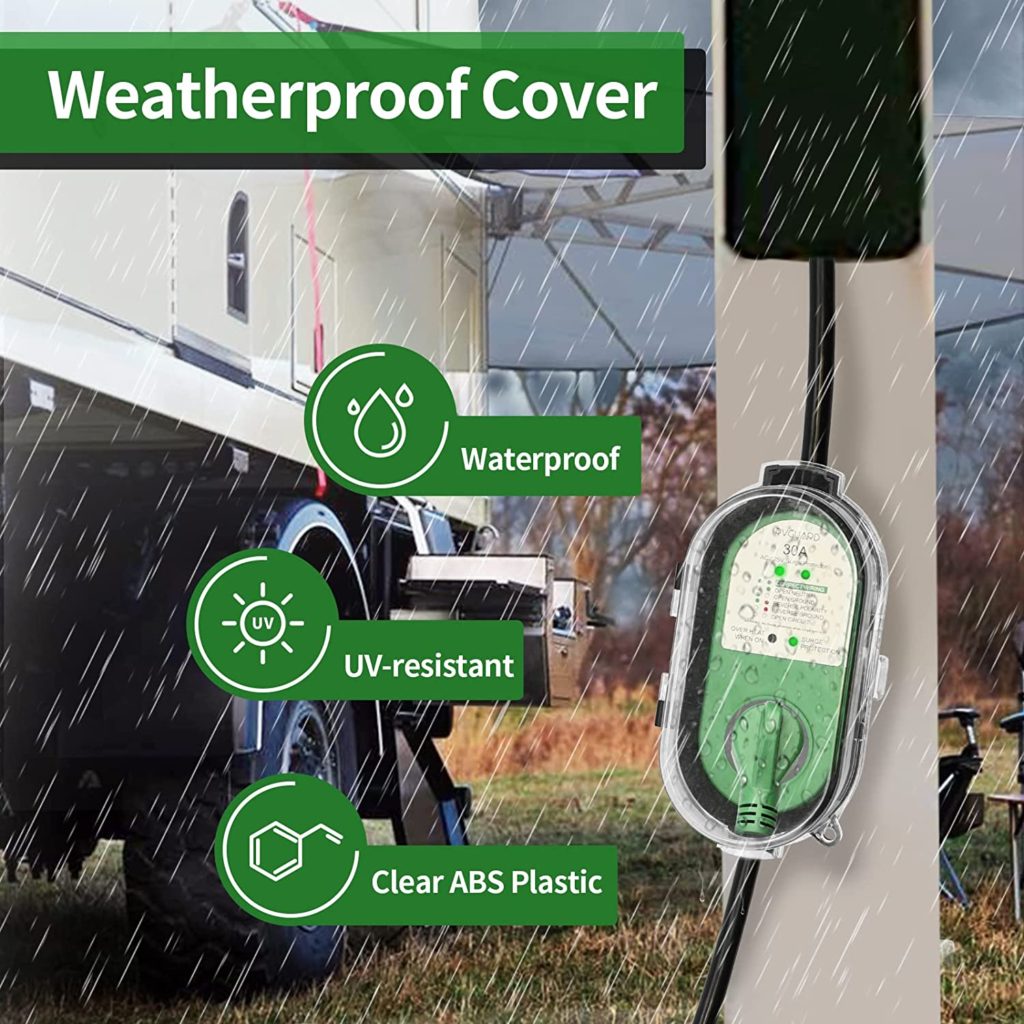
How long do surge protectors last?
It is suggested by industry professionals that your surge protector should be replaced every few years. With that in mind remember the life of your surge protector shortens if it has been put to use.
Has it been in use during multiple power outages? Has it tripped several times due to power surges?
Many RV surge protectors are single-use devices and will need to be replaced if tripped during use. This is something that you will want to take into consideration when shopping for a device.
Which surge protector is the best?
Choosing the best protection for you depends on how much you have invested and the level of peace of mind you require. A simple plug-and-play surge protector works great for my older class C RV since my investment was minimal and there are few electrical devices to destroy.
Someone who recently purchased a newer expensive RV will want to protect all the electrical components of their investment. For them, an EMS system to monitor all electrical activity and have maximum protection would be suggested.
Conclusion
The main takeaway from all this would be to know what you are getting before spending your hard-earned money. I’d recommend prioritizing amp and joules ratings, portable versus hardwired setups, and installation requirements.
Related Articles
Should I get an RV Inspection?
50 most asked RV questions answered
What to look for when shopping for an RV




